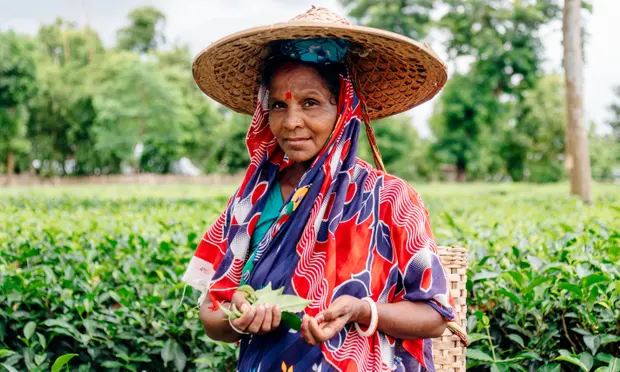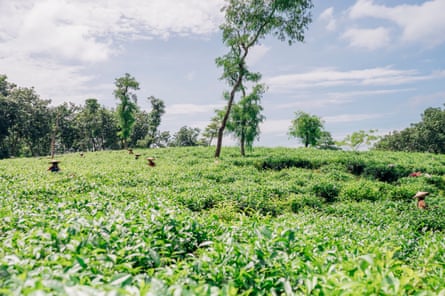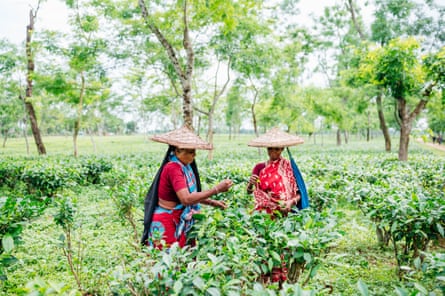‘Spreading Faster than Ever’: Bangladesh’s Tea Pickers Have World’s Highest Rate of Leprosy
ASIA--PACIFIC, 24 Apr 2023
Thaslima Begum and Kaamil Ahmed | The Guardian – TRANSCEND Media Service
Despite the WHO declaring it eliminated in 1998, thousands of tea pickers have caught the disease.

Aloka Gonju, a tea picker in Sylhet, was diagnosed with leprosy a year ago. Now she can only pick leaves with her right hand, which limits how much she can earn. Photograph: Ruth Towell
7 Apr 2023 – Aloka Gonju didn’t take much notice of the discoloured patch of skin on her left hand until her fingers began to stiffen and hurt. It became a struggle to pick leaves at the tea plantation where she works in Bangladesh.
“I had no idea what was happening to me,” says the 47-year-old, whose wages support her husband, four children and three grandchildren.
By the time she sought help, the nerve damage in her left hand was too extensive to regain its use. Gonju was diagnosed with leprosy two years ago.
According to the Leprosy Mission, the vast tea plantations of Sylhet in the north-east of the country, which employ about 600,000 workers – mostly women from minority groups – have the highest rate of leprosy in the world.
The charity, which works in 10 countries in Africa and Asia, found a prevalence rate of up to 15 cases for every 10,000 people, compared with fewer than one in 10,000 in the rest of the country. Most families have someone infected with the disease.
“In the tea estates of Sylhet, leprosy has been spreading much faster than our team has ever seen,” says Dr Benjamin Rozario, the resident medical officer for the mission in Bangladesh.

The UN’s special rapporteur on ending discrimination against people with leprosy, Alice Cruz, warned last month that the country could have a high number of hidden cases of the disease.
Leprosy is one of the world’s most neglected diseases. It is spread by moisture droplets passed through the air. Tea pickers, who usually live in crowded conditions in basic corrugated-iron homes on the plantations, and lack decent food, sanitation and health facilities, are particularly vulnerable to infection.
Drugs can stop the disease progressing, but they cannot reverse disability.
Gonju, who works on a plantation in Srimangal, still picks tea but now relies solely on her right hand. She is paid according to how much she can pick, so her reduced capacity means her and her family struggle by the end of each month.
“It breaks my heart but I’m lucky I started treatment when I did,” she says, while taking an afternoon break in the shade. “If I had lost both hands to leprosy, I would have lost my job and my home.”

She now helps to run a support group for people with leprosy living on her plantation.
The Leprosy Mission team has cured more than 1,600 cases since it started working in the plantations in 2017. It has set up pop-up clinics on the plantations and assigned community health workers and doctors to search for the signs of leprosy and provide the support and care patients need long term, before they lose the use of limbs, and potentially their livelihoods.
“For many here, the journey to the hospital is too expensive and too far away to walk,” says Rozario. “That’s why we bring the hospital to them.”
The World Health Organization declared leprosy eliminated in Bangladesh in 1998, but that meant it had fewer than one case for 10,000 people, not that there were no more infections. According to the WHO, the country still has the fifth-highest number of leprosy cases in the world.
Fazlur Rahman, mayor of Moulvibazar district in Sylhet, says the declaration led to a decline in the funding and attention devoted to the disease, which caused it to re-emerge.
“Since the WHO declared leprosy eliminated in Bangladesh, there has been a significant lack of funding and resources to address the issue, which still very much exists,” says Rahman. “We have to keep working until we’ve reached every person affected with leprosy in every district – nobody should be left behind.”
Bangladesh has pledged to wipe out the disease by 2030, but, during a visit to Bangladesh in February, the UN’s Cruz said that goal would not be achieved without more funding and action.
“I am concerned that the state administration is failing to implement this promise. Adequate budget allocation with clear targets, indicators and benchmarks is essential to turn the government’s pledges into reality,” Cruz said, adding that people with leprosy were not seeing the benefits of the country’s rapid economic growth.

Photograph: Ruth Towell
Protap Kurmi, 36, was a tractor driver on a tea plantation in Srimangal until he contracted the disease. He knew there was something wrong when he was unloading a trailer full of tea leaves and could not grip the handle.
Over the next few months, his fingers became stiff and began bending in towards his palms. The disease had already impaired the nerves in his hands by the time he was diagnosed by an outreach worker.
No longer able to drive a tractor, Kurmi works as a security guard on lower pay. He struggles to feed and wash himself, requiring help from his wife for daily tasks, and his hand trembles when he picks up a glass of water to drink.
“Before I was able to work and support my family but now I feel stuck … my wife and I were hoping to start a family but everything feels out of reach now,” Kurmi says.
Philip Gain, a Bangladesh researcher and director of Society for Environment and Human Development, said the conditions in which tea pickers live and work have a clear impact on their health. Many are undernourished, while serious illnesses often take a long time to be diagnosed because there are fewer health facilities and workers cannot afford time off to seek treatment.

“Workers don’t get casual leave, they don’t get maternity leave. You don’t find toilet and washing facilities in these areas, where 95% of tea workers are women. They eat their lunch – a very poor-quality lunch – under the shade of trees, out in the open,” says Gain.
“They can never own their land or the houses they live in; they don’t have economic opportunities to migrate outside the tea gardens; so they are tied in a captive situation.”
Last year, tea workers went on strike for better pay. The government intervened, and raised their daily salary from 120 Bangladeshi taka (90p) to 170 taka a day.
Gain says tea plantation owners claim they pay lower wages because they provide the workers and their children with accommodation, education and healthcare, but the services they do provide are basic.
Go to Original – theguardian.com
Tags: Bangladesh, Leprosy, Public Health, Science and Medicine, United Nations, WHO
DISCLAIMER: The statements, views and opinions expressed in pieces republished here are solely those of the authors and do not necessarily represent those of TMS. In accordance with title 17 U.S.C. section 107, this material is distributed without profit to those who have expressed a prior interest in receiving the included information for research and educational purposes. TMS has no affiliation whatsoever with the originator of this article nor is TMS endorsed or sponsored by the originator. “GO TO ORIGINAL” links are provided as a convenience to our readers and allow for verification of authenticity. However, as originating pages are often updated by their originating host sites, the versions posted may not match the versions our readers view when clicking the “GO TO ORIGINAL” links. This site contains copyrighted material the use of which has not always been specifically authorized by the copyright owner. We are making such material available in our efforts to advance understanding of environmental, political, human rights, economic, democracy, scientific, and social justice issues, etc. We believe this constitutes a ‘fair use’ of any such copyrighted material as provided for in section 107 of the US Copyright Law. In accordance with Title 17 U.S.C. Section 107, the material on this site is distributed without profit to those who have expressed a prior interest in receiving the included information for research and educational purposes. For more information go to: http://www.law.cornell.edu/uscode/17/107.shtml. If you wish to use copyrighted material from this site for purposes of your own that go beyond ‘fair use’, you must obtain permission from the copyright owner.